American Catholic History
Telling the stories of Catholics on these American shores from 1513 to today. We Catholics have such an incredible history in what are now the 50 states of the United States of America, and we hardly know it. From the canonized saints through the hundred-plus blesseds, venerables, and servants of God, to the hundreds more whose lives were sho-through with love of God, our country is covered from sea to shining sea with holy sites, historic structures, and the graves of great men and women of faith. We tell the stories that make them human, and so inspiring.
Episodes
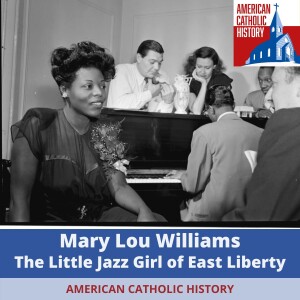
Wednesday Feb 12, 2025
Wednesday Feb 12, 2025
Born in 1910, Mary Lou Williams was a child prodigy. She played piano concerts in the homes of her neighbors in the East Liberty neighborhood of Pittsburgh as early as five years old, and was touring by her teens. After a meteoric rise as an arranger for the biggest names in jazz she became a mentor and mother-figure to many of the great jazz musicians of the 20th century. She was a remarkable pianist and composer in her own right — one of the most important of the 20th century. But she also saw the suffering and grief of those around her as drugs and lives of loose morals wreaked havoc on friends and loved ones. Eventually, in her 40s, she had a crisis and walke off the stage in Paris, vowing to never play music again. She instead did everything she could to help everyone she could, but she didn't know how to. She found refuge in a Catholic church in Harlem that she found was not kept locked, so she was able to go in to pray — though she was not Catholic. But her friend Lorraine Gillespie, wife of jazz great Dizzy Gillespie, was considering becoming Catholic. Together they met with the priest and eventually were received into the Church in 1957. After her conversion to Catholicism she returned to the jazz scene, seeing her music as a way to praise God and to evangelize. Her music found new depths of meaning in the prayers, devotions, and themes from Scripture that saved her. She believed that jazz was one of the most pure art forms, and wrote heart-wrenchingly beautiful music over the last few decades of her life, including three different Mass settings. She died in 1981 of cancer and is buried in Calvary Cemetery in Pittsburgh.
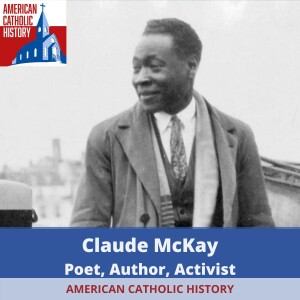
Thursday Feb 06, 2025
Thursday Feb 06, 2025
A leading figure in the Harlem Renaissance, poet and author Claude McKay had an idyllic childhood in Jamaica until his first experience of racism when he was 21. After emigrating to the United States in 1912 he became convinced that socialism held the answer to what ailed society, especially what kept black people down. His poetry and novels explored the themes of racial tension, the plight of poor black people in Harlem, and social struggle. He traveled extensively in Europe and Russia to find support for his efforts, but only became disillusioned with socialism. Eventually back in the U.S. his health failed and he was forced to seek help at a Friendship House, a Catholic endeavor. He became enamored of the Catholic approach to social justice and became active in both the Friendship House and the Catholic Worker movements. He came to believe in the Catholic faith, seeing in it the answers to the questions of justice and charity that he’d been seeking his entire life. He was received into the Catholic Church in 1944, four years before he died of heart failure.
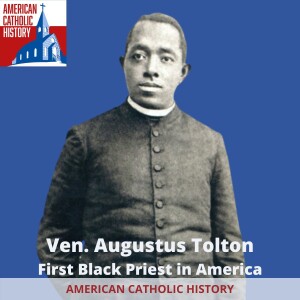
Monday Feb 03, 2025
Monday Feb 03, 2025
Father Augustus Tolton was the first black priest in America who identified as black. He was born a slave in Missouri in 1854, but his mother escaped with him and his two siblings to freedom in Illinois after the Civil War began. He endured racism among the children and parents at two schools, but also experienced great acceptance and love from the priests of his parishes and the nuns at the school. One of the priests, the Irishman Father Peter McGirr, took a special interest in "Gus," as he was known, and made sure he received a good education. Eventually, Father McGirr recognized the possibility that Gus had a vocation to the priesthood. After a few false starts, Father McGirr and the local Franciscan superior got Gus into the seminary of the Propaganda Fidei in Rome. Gus excelled as a seminarian in the Eternal City, and expected to be sent to Africa as a missionary. But the day before his ordination he found out he'd be returning to the U.S. He came back in 1887 and served as a beloved pastor in his home town of Quincy, Illinois, until a change in the local Church leadership made life very difficult for him, and he was transferred to the Archdiocese of Chicago. There he was once again a beloved pastor until his untimely death in 1896. In 2019 Father Augustus Tolton was declared Venerable by Pope Francis.
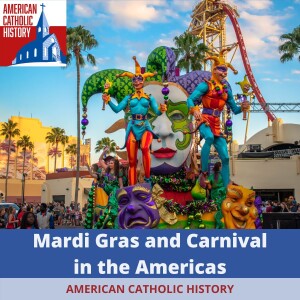
Friday Jan 31, 2025
Friday Jan 31, 2025
Mardi Gras, French for Fat Tuesday, is the day before Ash Wednesday. Fat Tuesday is the final day of the season known as Carnival in many French-based cities and lands all around the world. Carnival comes from the French from "goodbye, meat!" Carnival season begins on Epiphany, January 6, and goes to Lent. The celebration of Carnival, while not a formal and official liturgical season, is a time when Catholics remember the joy of Christmas, while also preparing for Lent. In this episode we talk about the history of Carnival and Mardi Gras in the US, going back to 1699. New Orleans and it famous French Quarter are best known for Mardi Gras, but Mobile, Alabama has the longer continuous celebration. And in New Orleans the celebration now is conducted by krewes, which run the parades and balls which usher in Lent. Enjoy this stroll through the history of a festive season and celebration, plus a great outtake at the end...
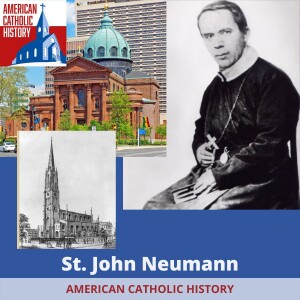
Monday Jan 27, 2025
Monday Jan 27, 2025
St. John Neumann was born in 1811 in Prachatice, Bohemia (in present-day Czech Republic). He was a good student, and while in seminary determined to become a missionary in the United States. But after completing his seminary studies he found difficulty in getting ordained or gaining passage to the U.S. But once in the U.S. he proved to be a tireless pastor. He was ordained in 1836 by Bishop John Dubois of New York. After time in diocesan parish work in the Buffalo area he joined the Redemptorists and was stationed in Pittsburgh, Pennsylvania, Norwalk, Ohio, New York City, and Baltimore, Maryland. In 1851 he was consecrated the fourth bishop of Philadelphia. He oversaw a period of incredible growth and construction in the Diocese, establishing so many schools that Phildelphia had the first diocesan school system in the country. His sudden death at 48 years old stunned and saddened everyone. He was canonized by Pope Paul VI in 1977.
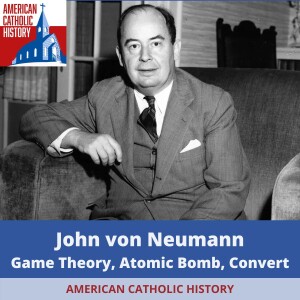
Friday Jan 24, 2025
Friday Jan 24, 2025
John von Neumann invented Game Theory, redefined ordinal numbers, contributed mightily to quantum mechanics, and developed the architecture which enables modern computing. He also designed the trigger mechanism which detonated the atomic bomb dropped on Hiroshima, and he was key in developing "Mutually Assured Destruction" as a means of balancing the world order as the nuclear age dawned. He possessed an intellect rivaled by only a handful of other persons, and he was, without doubt, one of the most important individuals of 20th century. He also was agnostic for the majority of his life, though he was baptized Catholic at 30 years old in order to marry his Catholic fiancee. But when suddenly facing his own death at just 53 years old, he had to face the questions of the afterlife and the existence of God. Ever the gamer, Pascal's Wager gave him the argument that convinced him to return to the Catholicism of his first wife, and then significant conversations with a learned Benedictine priest helped him to understand the faith and desire the sacraments. He died with the Last Rites in January 1957.

Tuesday Jan 21, 2025
Tuesday Jan 21, 2025
The Land of the Cross Tipped Churches is a region in west-central Ohio. German Catholics fled the wars and upheaval of their homeland in the early- and mid-19th century, and many settled in the United States. A number of these groups settled in a region of western Ohio, and in the 1840s Archbishop Purcell invited the Fathers of the Most Precious Blood to come and minister to these German-speaking Catholics. Father Francis de Sales Brunner led 14 confreres over, and over the ensuing decades the Precious Blood Fathers built more than 60 churches, schools, a seminary, convents, and rectories in a relatively small area. Over the years the construction became more elaborate until many of these churches had tall, slender steeples tipped with crosses. And since they were built so near to each other across a very flat landscape, the area became known as "The Land of the Cross-Tipped Churches." Nowadays road signs mark out a scenic byway that would take the pilgrim on a journey through the region, seeing 50 of the churches and other structures. The most prominent of them, the former convent of Mariastein, is now the home of the second-largest collection of relics outside the Vatican.
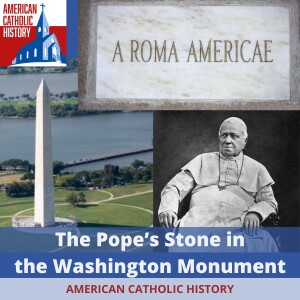
Thursday Jan 16, 2025
Thursday Jan 16, 2025
In 1854 a slab of marble donated by Pope Pius IX arrived in Washington, D.C. He had it engraved “A Roma Americae,” or “From Rome to America,” as a sign of goodwill. He had sent it over to be included in the Washington Monument, which was then under construction. Many foreign governments had sent similar contributions to honor America’s first president. The Know Nothings, however, had no intention of allowing a gift from the Pope to be included in the Washington Monument. They were certain the stone was a sign of darker intentions by the Pope. So on March 9, 1854, under cover of darkness, a group of these anti-Catholics broke into the yard, stole the stone, and after damaging it with hammers they dropped it in the Potomac River. No one was ever credibly accused of the crime, despite reward offers and a public outcry. Many years later, however, after a tip, the stone was discovered… only to disappear again. But today, there is a stone from the Pope in the Washington Monument, this one was provided by Pope John Paul II in 1982.
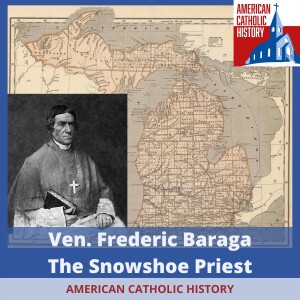
Monday Jan 13, 2025
Monday Jan 13, 2025
Frederic Baraga was the first bishop of the Diocese of Marquette, in Michigan’s upper peninsula. He had come to northern Michigan as a missionary in 1831, after immigrating from the Austrian Empire — an area of it that is in modern day Slovenia. Baraga proved a tireless missionary, traveling hundreds of miles by foot, including in snowshoes during the long, harsh winters, as well as by boat. He converted thousands of Chippewa and Ottawa and other natives, and he ministered to the settlers, including those who came north for the copper boom. He faced resistance from Protestant missionaries, French fur traders, and the U.S. federal government, all of whom had their own agendas for the natives. Devotion to him began shortly after his death in 1868. He was declared Venerable in 2012.
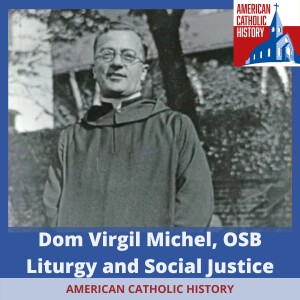
Friday Dec 13, 2024
Friday Dec 13, 2024
Dom Virgil Michel, OSB was a visionary leader who recognized some problems affecting the Church of his day and believed that the way to fix those problems was through the liturgy. He recognized that by improving knowledge of and participation in the liturgy, and making the liturgy central to both catechesis and social justice, more people would come to know Christ more deeply, and would thereby be motivated to do great good. He spearheaded the liturgical movement, wrote texts to reform catechetics and religious education, and was active in the emerging social justice movement. He firmly believed “lex orandi, lex credendi, lex vivendi,” which means “how you pray is how you believe is how you live.” Through founding the journal Orate Fratres and the Liturgical Press in Collegeville, Minnesota he had a profound influence on many who came later, but he died unfortunately young in 1938.










